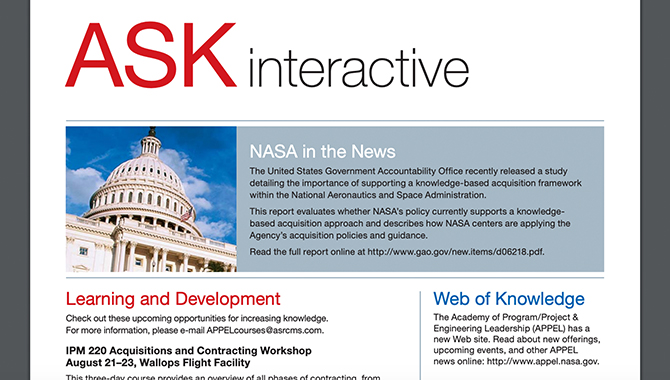By David Oberhettinger
The engineering and operation of extremely complex and technically advanced systems pose significant risks, and we must accept the likelihood of design errors throughout the life cycle. Expensive mistakes and lost opportunities become less acceptable, however, when it is discovered that the enterprise already knew how to avoid them. Lessons learned can be an effective medium for communicating proven mission success factors and warning of especially risky engineering and procurement practices.
Establishing a Formal NASA Lessons Learned Process
The NASA Office of the Chief Engineer is taking steps to establish a formal lessons learned process to supplant largely ad hoc efforts by the field centers. The impetus for process improvements stems from findings by the General Accounting Office that NASA lessons learned were not being effectively used and findings from the Columbia Accident Investigation Board report that NASA “has not demonstrated the characteristics of a learning organization.” NASA is turning to a formal lessons learned process that has been used by the NASA/Caltech Jet Propulsion Laboratory for twenty years. Based on this model, NASA issued NPR 7120.6, The NASA Lessons Learned Process, in March 2005. It calls for each NASA field center to establish a Lessons Learned Committee and infuse lesson learned recommendations into center business practices.
Jet Propulsion Laboratory Experience
In 1984 Jet Propulsion Laboratory (JPL) demonstrated enterprise-wide commitment to a formal lessons learned process through the establishment of the JPL Lessons Learned Committee (LLC). The JPL LLC includes representatives of the major technical and mission assurance organizations and is charged with real-time “wordsmithing” of draft lessons. The LLC meets weekly to review anomaly reports, mishap investigation reports, and informal communications to identify lesson learned candidates, and to rank the candidates according to the following criteria:
- Potential impact on mission success
- Applicability to other current and planned space flight projects
- Lack of coverage of the underlying issues in previous lessons
Authors are assigned to high-priority topics. When a draft is received, the LLC revalidates the topic as a suitable lesson learned, verifies the stated facts, and edits the draft during one of its regular meetings. The committee gives particular attention to ensuring that the lesson learned recommendation is readily “actionable” within the JPL engineering culture. An “actionable” lesson learned recommendation is neither too broad to be applied nor so detailed that it tells an expert how to do his or her job.
The LLC-approved lesson is then sent to the NASA Headquarters Data Manager for review and posting. This formal JPL process has been resource intensive, and it does not generate large numbers of lessons learned, but it provides credible alerts of proven threats to mission success.
Lessons Learned Infusion
Verifying space flight project compliance with the published lesson learned recommendations has grown to be a daunting task due to the sheer size of the NASA lesson learned compendium. With more than 1,500 lessons learned in the NASA system, iterative review by project personnel at major project milestones may be impractical. Nor can JPL rely on a passive system in which technical specialists within the JPL line organization elect to consult lessons learned for alerts.
In 2002, JPL opted to end its passive reliance on having engineers consult the lessons learned compendium and to move toward a closed-loop system. Unless active measures are taken to infuse recommendations into enterprise-wide practices, an extensive and well-validated set of guidelines may degenerate into a “data morgue.” Each JPL lesson learned recommendation was assigned to one or more JPL process owners for action—more than 600 assignments—via the closed-loop JPL Corrective Action Notice (CAN) system. When a process owner demonstrates that a recommendation has been fully incorporated into JPL procedures and training, the infusion is complete and the CAN is closed.
A JPL lesson learned published in March 2006 (https://www.nasa.gov/offices/oce/
llis/imported_content/lesson_1712.html) pointed out the need for substantial design margin to encompass a poorly understood environment. Mars Exploration Rover designers had responded to a high level of uncertainty regarding Martian winds by providing the lander with a set of small, sideways-pointing (transverse) rockets and adding a small camera to directly sense horizontal drift. This redesign to reduce the risk that the descending lander would graze Martian terrain was implemented only eighteen months before launch.
A video simulation available at http://marsrovers.jpl.nasa. gov/gallery/video/movies/spirit/AMA_Hi_Res_Animation.mpg is based on actual Mars landing data; it looks north and shows the main rockets decelerating the craft, and the transverse rockets canceling the ground drift from a westerly wind. Without this capability from the redesign, the lateral motion across the rugged incline of the Gusev Crater would likely have damaged the now- operating Spirit rover. To infuse this lesson, JPL design guidelines for future planetary missions will call for countering significant environmental risks at the upper bounds of their probable severity, with substantial margin.
Due to the backlog of published lessons extending back to the Voyager era, only half the JPL contributions to the NASA system have been fully infused. But after an independent assessment confirms the adequacy of the disposition of a given lesson learned, JPL will no longer have to fully depend on periodic review of that lesson.
Status of the NASA Initiative
The NASA field centers have responded positively to the Headquarters lessons learned initiative. The NASA Office of the Chief Engineer has conducted rollouts of NPR 7120.6 at each of the field centers, and the centers are organizing their Lessons Learned Committees and infusion processes.
To complement these efforts, NASA has recently transferred its collection of lessons learned from the previous Lessons Learned Information System to the NASA Engineering Network (NEN). The NEN offers expanded search capabilities, and planned enhancements will include advanced data mining capabilities.








